Leadership and Management in Nursing: Theories, Styles, and Practices
VerifiedAdded on 2021/04/21
|17
|4671
|120
Essay
AI Summary
This essay delves into the critical aspects of leadership and management within the nursing profession. It begins by introducing the significance of effective leadership in healthcare settings, emphasizing its role in balancing the needs of patients, staff, and the organization. The essay then explores the contributions and limitations of three key management theories: classical management, bureaucratic management, and the human relations movement. It provides a detailed analysis of each theory, discussing their core principles, applications, and drawbacks. Furthermore, the assignment presents a personal viewpoint on the most suitable management styles for organizations, alongside preferred management processes to achieve organizational objectives in today's challenging environment. The discussion highlights the importance of leadership skills for nurse managers and the need to align management styles with organizational goals. The essay concludes by emphasizing the application of these theories in clinical settings and their impact on healthcare quality and cost-effectiveness.
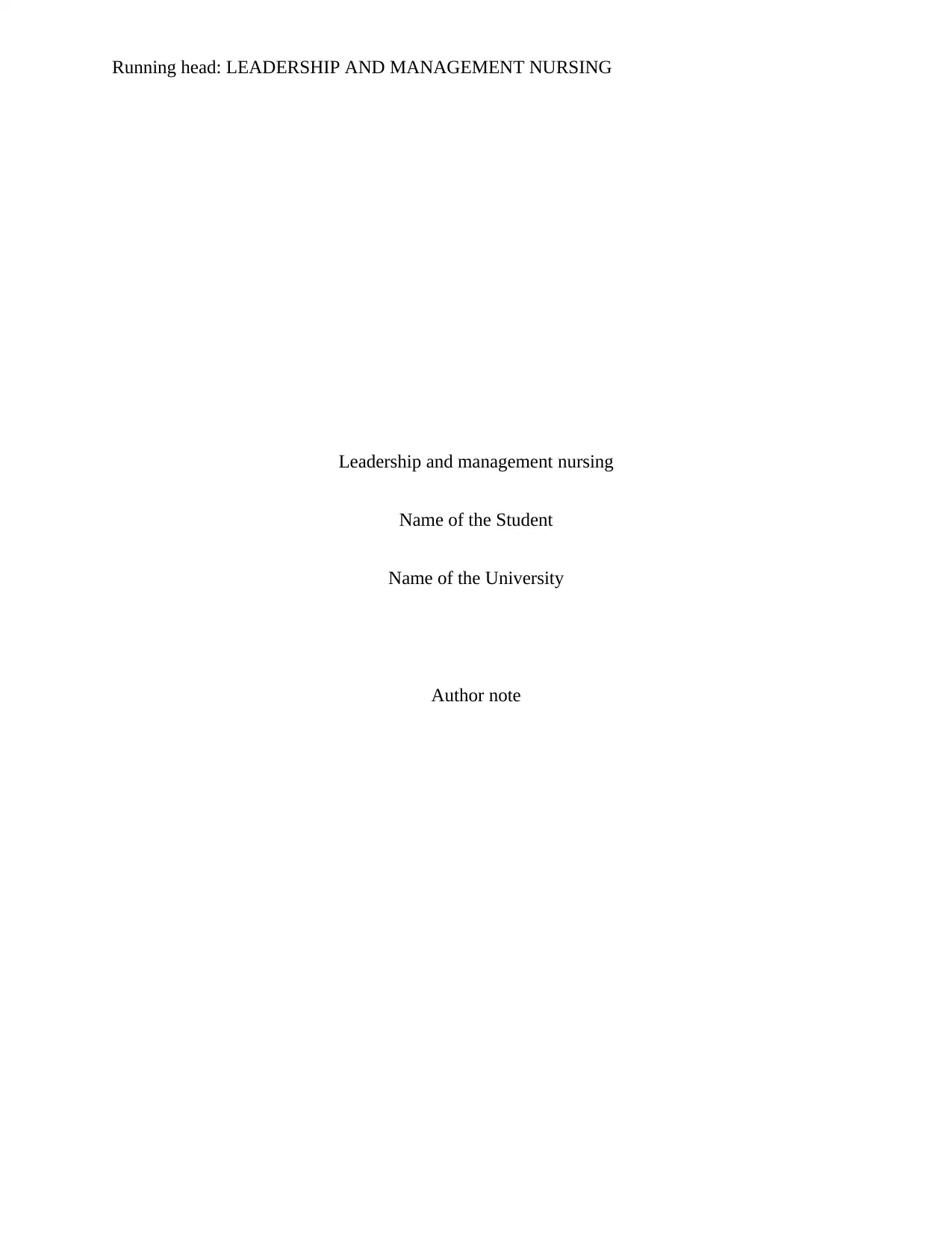
Running head: LEADERSHIP AND MANAGEMENT NURSING
Leadership and management nursing
Name of the Student
Name of the University
Author note
Leadership and management nursing
Name of the Student
Name of the University
Author note
Paraphrase This Document
Need a fresh take? Get an instant paraphrase of this document with our AI Paraphraser
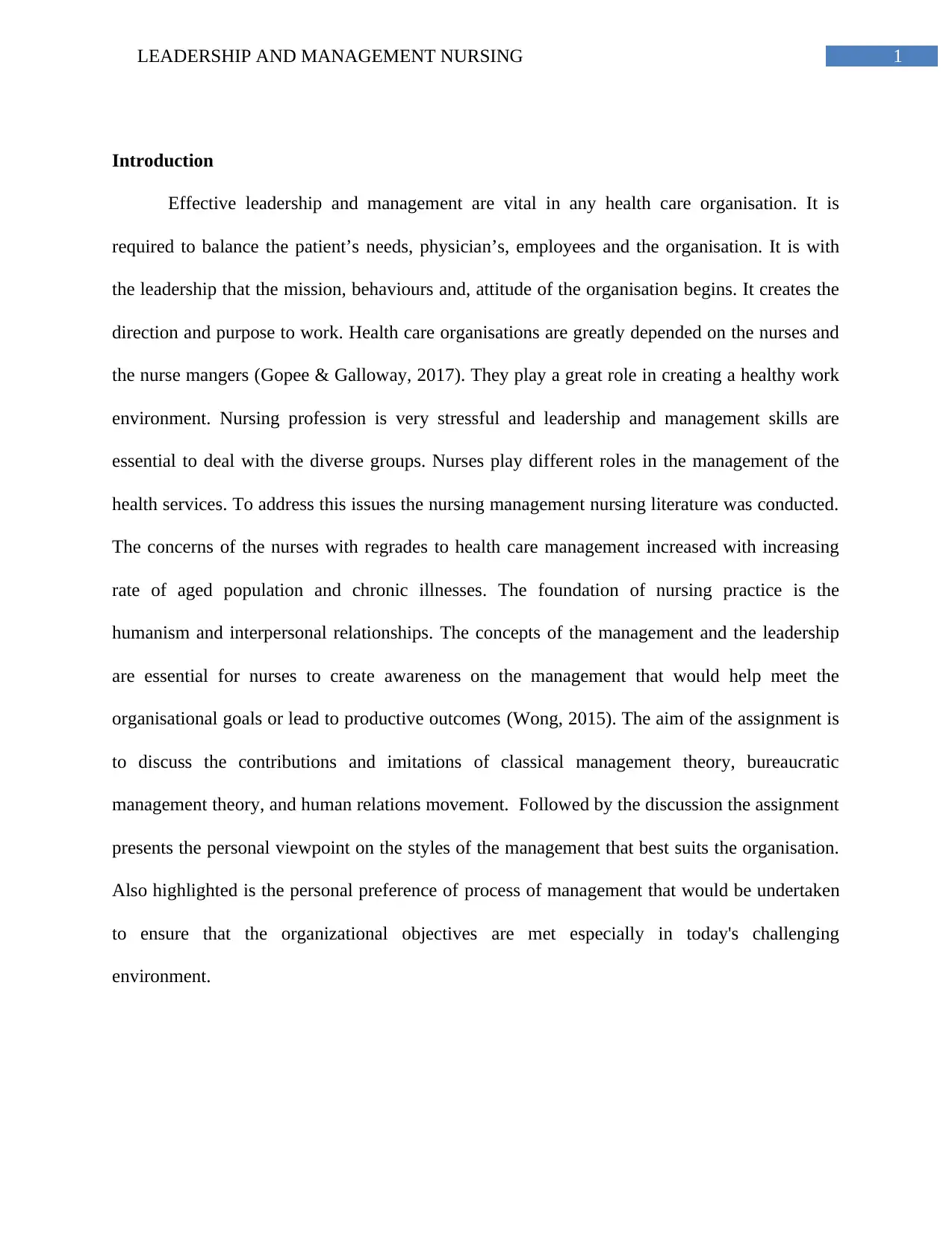
1LEADERSHIP AND MANAGEMENT NURSING
Introduction
Effective leadership and management are vital in any health care organisation. It is
required to balance the patient’s needs, physician’s, employees and the organisation. It is with
the leadership that the mission, behaviours and, attitude of the organisation begins. It creates the
direction and purpose to work. Health care organisations are greatly depended on the nurses and
the nurse mangers (Gopee & Galloway, 2017). They play a great role in creating a healthy work
environment. Nursing profession is very stressful and leadership and management skills are
essential to deal with the diverse groups. Nurses play different roles in the management of the
health services. To address this issues the nursing management nursing literature was conducted.
The concerns of the nurses with regrades to health care management increased with increasing
rate of aged population and chronic illnesses. The foundation of nursing practice is the
humanism and interpersonal relationships. The concepts of the management and the leadership
are essential for nurses to create awareness on the management that would help meet the
organisational goals or lead to productive outcomes (Wong, 2015). The aim of the assignment is
to discuss the contributions and imitations of classical management theory, bureaucratic
management theory, and human relations movement. Followed by the discussion the assignment
presents the personal viewpoint on the styles of the management that best suits the organisation.
Also highlighted is the personal preference of process of management that would be undertaken
to ensure that the organizational objectives are met especially in today's challenging
environment.
Introduction
Effective leadership and management are vital in any health care organisation. It is
required to balance the patient’s needs, physician’s, employees and the organisation. It is with
the leadership that the mission, behaviours and, attitude of the organisation begins. It creates the
direction and purpose to work. Health care organisations are greatly depended on the nurses and
the nurse mangers (Gopee & Galloway, 2017). They play a great role in creating a healthy work
environment. Nursing profession is very stressful and leadership and management skills are
essential to deal with the diverse groups. Nurses play different roles in the management of the
health services. To address this issues the nursing management nursing literature was conducted.
The concerns of the nurses with regrades to health care management increased with increasing
rate of aged population and chronic illnesses. The foundation of nursing practice is the
humanism and interpersonal relationships. The concepts of the management and the leadership
are essential for nurses to create awareness on the management that would help meet the
organisational goals or lead to productive outcomes (Wong, 2015). The aim of the assignment is
to discuss the contributions and imitations of classical management theory, bureaucratic
management theory, and human relations movement. Followed by the discussion the assignment
presents the personal viewpoint on the styles of the management that best suits the organisation.
Also highlighted is the personal preference of process of management that would be undertaken
to ensure that the organizational objectives are met especially in today's challenging
environment.
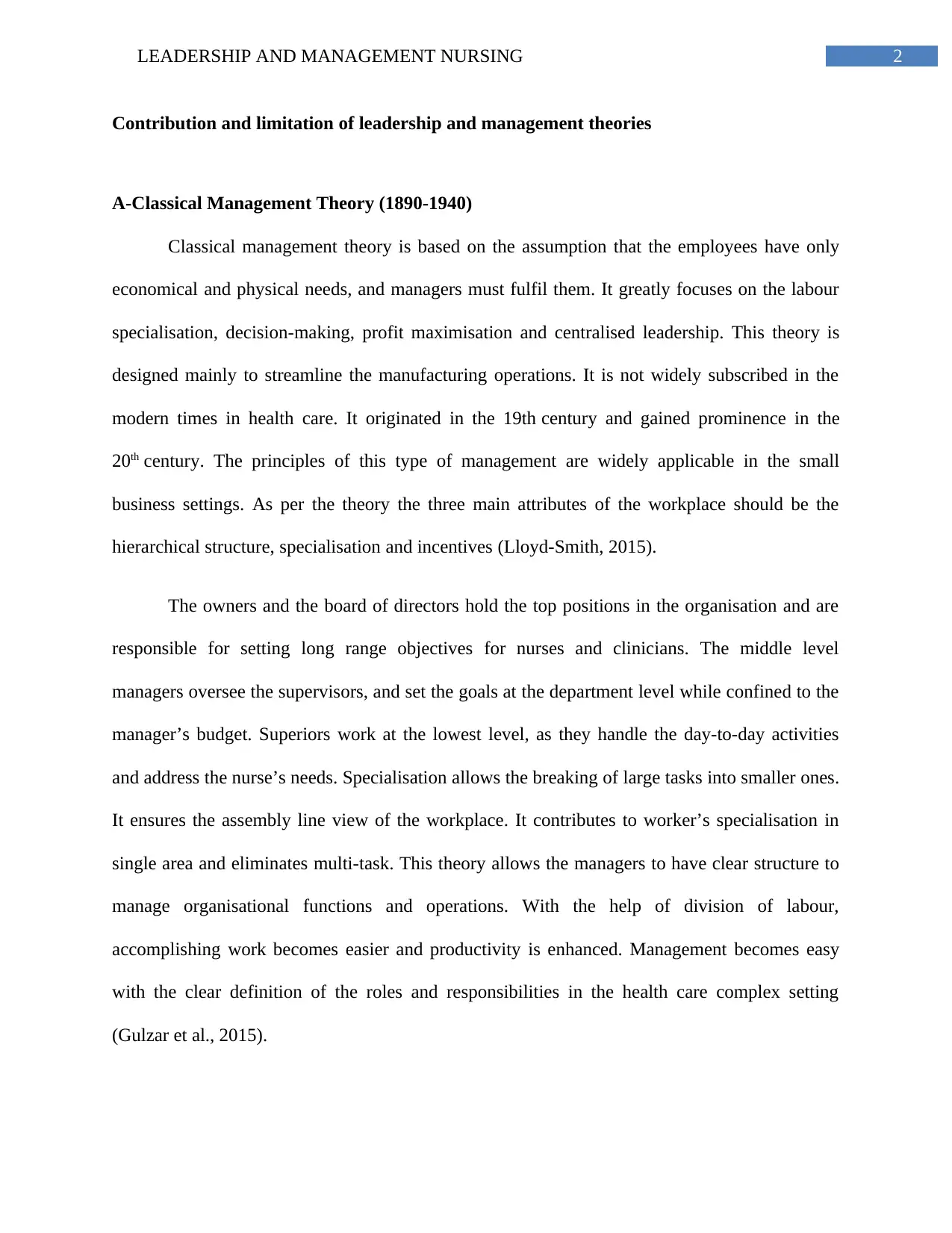
2LEADERSHIP AND MANAGEMENT NURSING
Contribution and limitation of leadership and management theories
A-Classical Management Theory (1890-1940)
Classical management theory is based on the assumption that the employees have only
economical and physical needs, and managers must fulfil them. It greatly focuses on the labour
specialisation, decision-making, profit maximisation and centralised leadership. This theory is
designed mainly to streamline the manufacturing operations. It is not widely subscribed in the
modern times in health care. It originated in the 19th century and gained prominence in the
20th century. The principles of this type of management are widely applicable in the small
business settings. As per the theory the three main attributes of the workplace should be the
hierarchical structure, specialisation and incentives (Lloyd-Smith, 2015).
The owners and the board of directors hold the top positions in the organisation and are
responsible for setting long range objectives for nurses and clinicians. The middle level
managers oversee the supervisors, and set the goals at the department level while confined to the
manager’s budget. Superiors work at the lowest level, as they handle the day-to-day activities
and address the nurse’s needs. Specialisation allows the breaking of large tasks into smaller ones.
It ensures the assembly line view of the workplace. It contributes to worker’s specialisation in
single area and eliminates multi-task. This theory allows the managers to have clear structure to
manage organisational functions and operations. With the help of division of labour,
accomplishing work becomes easier and productivity is enhanced. Management becomes easy
with the clear definition of the roles and responsibilities in the health care complex setting
(Gulzar et al., 2015).
Contribution and limitation of leadership and management theories
A-Classical Management Theory (1890-1940)
Classical management theory is based on the assumption that the employees have only
economical and physical needs, and managers must fulfil them. It greatly focuses on the labour
specialisation, decision-making, profit maximisation and centralised leadership. This theory is
designed mainly to streamline the manufacturing operations. It is not widely subscribed in the
modern times in health care. It originated in the 19th century and gained prominence in the
20th century. The principles of this type of management are widely applicable in the small
business settings. As per the theory the three main attributes of the workplace should be the
hierarchical structure, specialisation and incentives (Lloyd-Smith, 2015).
The owners and the board of directors hold the top positions in the organisation and are
responsible for setting long range objectives for nurses and clinicians. The middle level
managers oversee the supervisors, and set the goals at the department level while confined to the
manager’s budget. Superiors work at the lowest level, as they handle the day-to-day activities
and address the nurse’s needs. Specialisation allows the breaking of large tasks into smaller ones.
It ensures the assembly line view of the workplace. It contributes to worker’s specialisation in
single area and eliminates multi-task. This theory allows the managers to have clear structure to
manage organisational functions and operations. With the help of division of labour,
accomplishing work becomes easier and productivity is enhanced. Management becomes easy
with the clear definition of the roles and responsibilities in the health care complex setting
(Gulzar et al., 2015).
⊘ This is a preview!⊘
Do you want full access?
Subscribe today to unlock all pages.

Trusted by 1+ million students worldwide

3LEADERSHIP AND MANAGEMENT NURSING
According to this theory higher wages will increase the work productivity. This theory
applies scientific methods and techniques to improve the working conditions. It eventually
contributes to improved relationships between workers and managers. It is advantageous to
workers as they get training and development opportunities. Scientific selection and training of
the employees increases the employee’s efficiency. Application of theory in clinical setting
considered to ensure fair section of health care professionals. The advantage of the theory is
ensuring the line of authority. Using this theory of management by the leaders and managers
contributes to society as people get better product and services, better utilisation of resources,
lowers the cost of the product and services. Using better product improves the standard of living
of people. In nursing using this theory to better manage medical resources improves care quality
and decrease hospital stay of the patients. It decreases the health care costs (Huber, 2017).
There are limitations to the classical approach to management. It is mainly applicable for
the simple organisations. Considering the health care sector to be dynamic and complex, using
this theory is a drawback today. It is focused on the single best way to manage by focusing on
the individual performance instead of the group process. The drawback of this approach comes
from division of the labour into the efficient and inefficient categories. The theory of
management emphasise on the increase in productivity by job specialisation and the job
repetitions. Nurses on the other hand require diverse skill sets. It is the limitation as this approach
only leads to monotony. It reduces the scope of innovation and creativity. This theory of
management rarely focuses on the human factors and relationships. It emphasises on monetary
benefits to motivate workers. There is no scope of human resource development. Such
management only leads to frustration and emotional distress among the employees. Since
humans are treated as machines there is never a hope of job satisfaction and increase in morale. It
According to this theory higher wages will increase the work productivity. This theory
applies scientific methods and techniques to improve the working conditions. It eventually
contributes to improved relationships between workers and managers. It is advantageous to
workers as they get training and development opportunities. Scientific selection and training of
the employees increases the employee’s efficiency. Application of theory in clinical setting
considered to ensure fair section of health care professionals. The advantage of the theory is
ensuring the line of authority. Using this theory of management by the leaders and managers
contributes to society as people get better product and services, better utilisation of resources,
lowers the cost of the product and services. Using better product improves the standard of living
of people. In nursing using this theory to better manage medical resources improves care quality
and decrease hospital stay of the patients. It decreases the health care costs (Huber, 2017).
There are limitations to the classical approach to management. It is mainly applicable for
the simple organisations. Considering the health care sector to be dynamic and complex, using
this theory is a drawback today. It is focused on the single best way to manage by focusing on
the individual performance instead of the group process. The drawback of this approach comes
from division of the labour into the efficient and inefficient categories. The theory of
management emphasise on the increase in productivity by job specialisation and the job
repetitions. Nurses on the other hand require diverse skill sets. It is the limitation as this approach
only leads to monotony. It reduces the scope of innovation and creativity. This theory of
management rarely focuses on the human factors and relationships. It emphasises on monetary
benefits to motivate workers. There is no scope of human resource development. Such
management only leads to frustration and emotional distress among the employees. Since
humans are treated as machines there is never a hope of job satisfaction and increase in morale. It
Paraphrase This Document
Need a fresh take? Get an instant paraphrase of this document with our AI Paraphraser
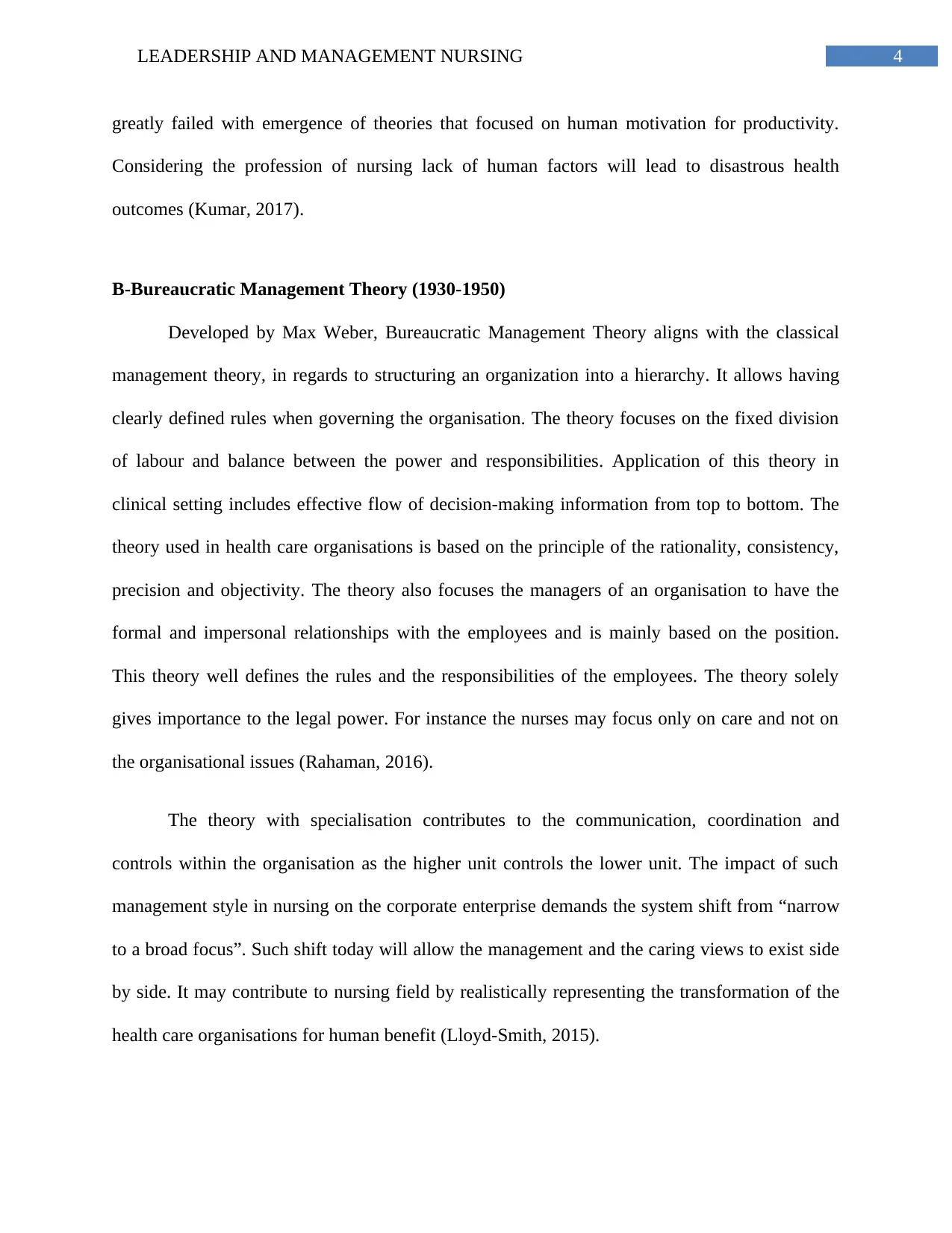
4LEADERSHIP AND MANAGEMENT NURSING
greatly failed with emergence of theories that focused on human motivation for productivity.
Considering the profession of nursing lack of human factors will lead to disastrous health
outcomes (Kumar, 2017).
B-Bureaucratic Management Theory (1930-1950)
Developed by Max Weber, Bureaucratic Management Theory aligns with the classical
management theory, in regards to structuring an organization into a hierarchy. It allows having
clearly defined rules when governing the organisation. The theory focuses on the fixed division
of labour and balance between the power and responsibilities. Application of this theory in
clinical setting includes effective flow of decision-making information from top to bottom. The
theory used in health care organisations is based on the principle of the rationality, consistency,
precision and objectivity. The theory also focuses the managers of an organisation to have the
formal and impersonal relationships with the employees and is mainly based on the position.
This theory well defines the rules and the responsibilities of the employees. The theory solely
gives importance to the legal power. For instance the nurses may focus only on care and not on
the organisational issues (Rahaman, 2016).
The theory with specialisation contributes to the communication, coordination and
controls within the organisation as the higher unit controls the lower unit. The impact of such
management style in nursing on the corporate enterprise demands the system shift from “narrow
to a broad focus”. Such shift today will allow the management and the caring views to exist side
by side. It may contribute to nursing field by realistically representing the transformation of the
health care organisations for human benefit (Lloyd-Smith, 2015).
greatly failed with emergence of theories that focused on human motivation for productivity.
Considering the profession of nursing lack of human factors will lead to disastrous health
outcomes (Kumar, 2017).
B-Bureaucratic Management Theory (1930-1950)
Developed by Max Weber, Bureaucratic Management Theory aligns with the classical
management theory, in regards to structuring an organization into a hierarchy. It allows having
clearly defined rules when governing the organisation. The theory focuses on the fixed division
of labour and balance between the power and responsibilities. Application of this theory in
clinical setting includes effective flow of decision-making information from top to bottom. The
theory used in health care organisations is based on the principle of the rationality, consistency,
precision and objectivity. The theory also focuses the managers of an organisation to have the
formal and impersonal relationships with the employees and is mainly based on the position.
This theory well defines the rules and the responsibilities of the employees. The theory solely
gives importance to the legal power. For instance the nurses may focus only on care and not on
the organisational issues (Rahaman, 2016).
The theory with specialisation contributes to the communication, coordination and
controls within the organisation as the higher unit controls the lower unit. The impact of such
management style in nursing on the corporate enterprise demands the system shift from “narrow
to a broad focus”. Such shift today will allow the management and the caring views to exist side
by side. It may contribute to nursing field by realistically representing the transformation of the
health care organisations for human benefit (Lloyd-Smith, 2015).
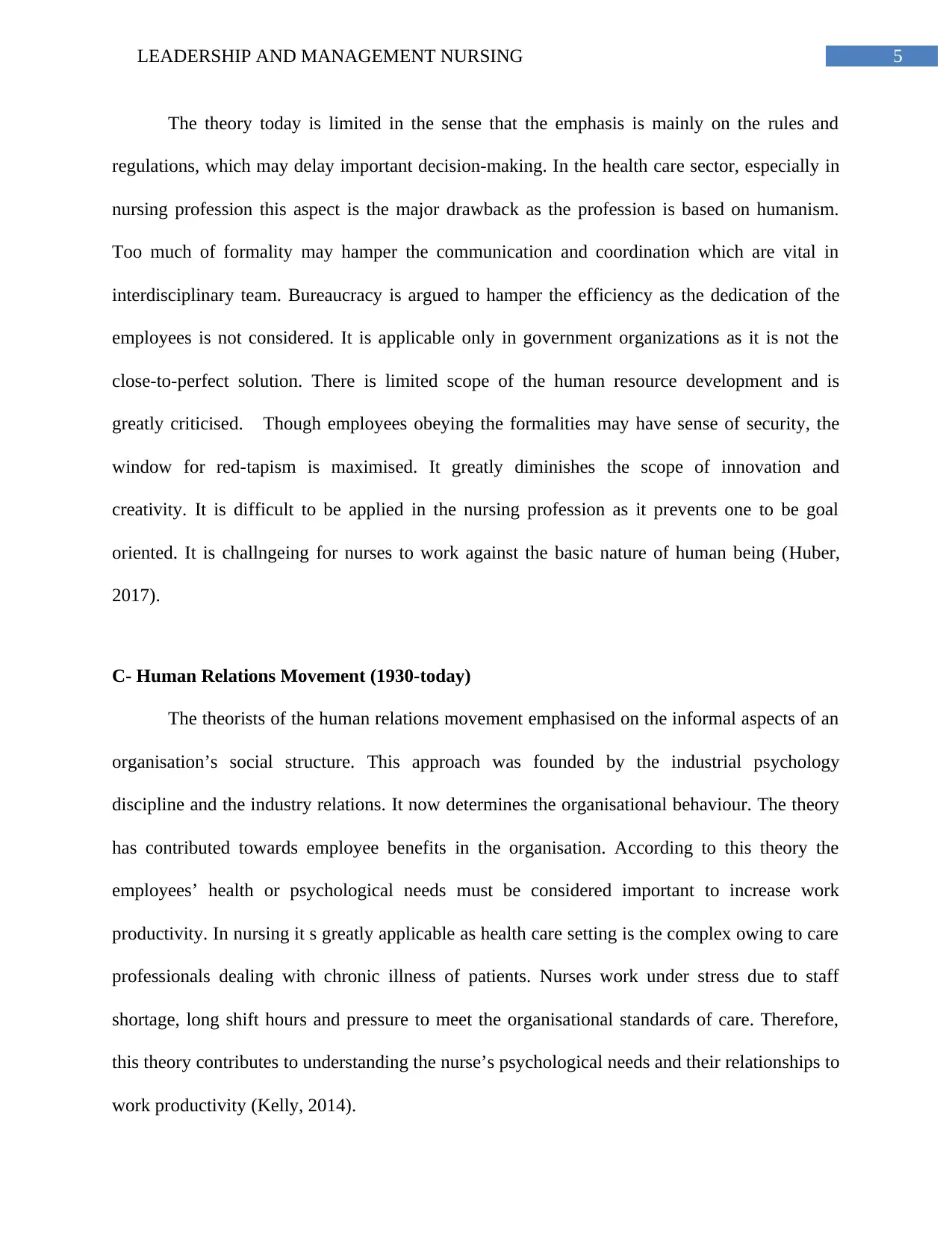
5LEADERSHIP AND MANAGEMENT NURSING
The theory today is limited in the sense that the emphasis is mainly on the rules and
regulations, which may delay important decision-making. In the health care sector, especially in
nursing profession this aspect is the major drawback as the profession is based on humanism.
Too much of formality may hamper the communication and coordination which are vital in
interdisciplinary team. Bureaucracy is argued to hamper the efficiency as the dedication of the
employees is not considered. It is applicable only in government organizations as it is not the
close-to-perfect solution. There is limited scope of the human resource development and is
greatly criticised. Though employees obeying the formalities may have sense of security, the
window for red-tapism is maximised. It greatly diminishes the scope of innovation and
creativity. It is difficult to be applied in the nursing profession as it prevents one to be goal
oriented. It is challngeing for nurses to work against the basic nature of human being (Huber,
2017).
C- Human Relations Movement (1930-today)
The theorists of the human relations movement emphasised on the informal aspects of an
organisation’s social structure. This approach was founded by the industrial psychology
discipline and the industry relations. It now determines the organisational behaviour. The theory
has contributed towards employee benefits in the organisation. According to this theory the
employees’ health or psychological needs must be considered important to increase work
productivity. In nursing it s greatly applicable as health care setting is the complex owing to care
professionals dealing with chronic illness of patients. Nurses work under stress due to staff
shortage, long shift hours and pressure to meet the organisational standards of care. Therefore,
this theory contributes to understanding the nurse’s psychological needs and their relationships to
work productivity (Kelly, 2014).
The theory today is limited in the sense that the emphasis is mainly on the rules and
regulations, which may delay important decision-making. In the health care sector, especially in
nursing profession this aspect is the major drawback as the profession is based on humanism.
Too much of formality may hamper the communication and coordination which are vital in
interdisciplinary team. Bureaucracy is argued to hamper the efficiency as the dedication of the
employees is not considered. It is applicable only in government organizations as it is not the
close-to-perfect solution. There is limited scope of the human resource development and is
greatly criticised. Though employees obeying the formalities may have sense of security, the
window for red-tapism is maximised. It greatly diminishes the scope of innovation and
creativity. It is difficult to be applied in the nursing profession as it prevents one to be goal
oriented. It is challngeing for nurses to work against the basic nature of human being (Huber,
2017).
C- Human Relations Movement (1930-today)
The theorists of the human relations movement emphasised on the informal aspects of an
organisation’s social structure. This approach was founded by the industrial psychology
discipline and the industry relations. It now determines the organisational behaviour. The theory
has contributed towards employee benefits in the organisation. According to this theory the
employees’ health or psychological needs must be considered important to increase work
productivity. In nursing it s greatly applicable as health care setting is the complex owing to care
professionals dealing with chronic illness of patients. Nurses work under stress due to staff
shortage, long shift hours and pressure to meet the organisational standards of care. Therefore,
this theory contributes to understanding the nurse’s psychological needs and their relationships to
work productivity (Kelly, 2014).
⊘ This is a preview!⊘
Do you want full access?
Subscribe today to unlock all pages.

Trusted by 1+ million students worldwide
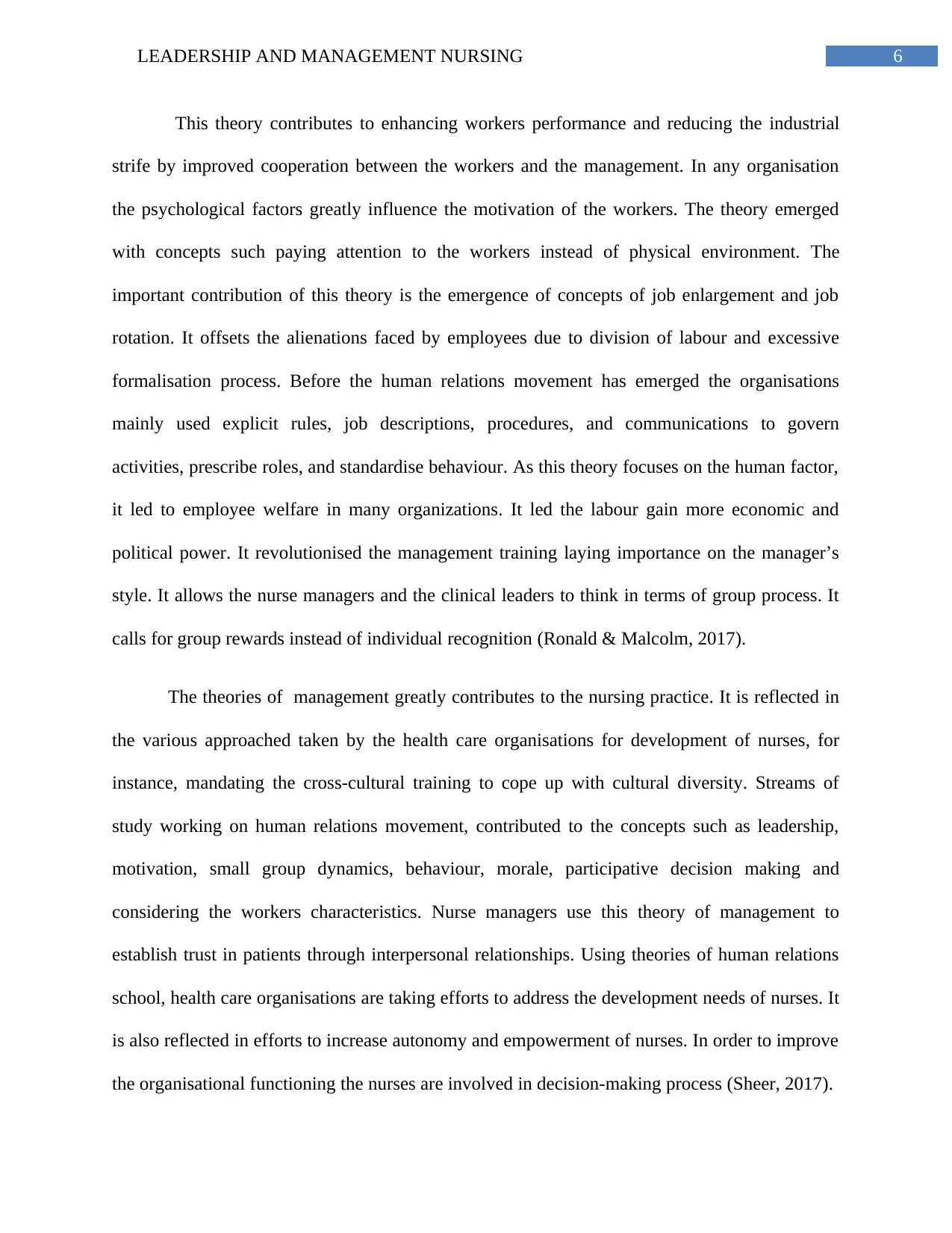
6LEADERSHIP AND MANAGEMENT NURSING
This theory contributes to enhancing workers performance and reducing the industrial
strife by improved cooperation between the workers and the management. In any organisation
the psychological factors greatly influence the motivation of the workers. The theory emerged
with concepts such paying attention to the workers instead of physical environment. The
important contribution of this theory is the emergence of concepts of job enlargement and job
rotation. It offsets the alienations faced by employees due to division of labour and excessive
formalisation process. Before the human relations movement has emerged the organisations
mainly used explicit rules, job descriptions, procedures, and communications to govern
activities, prescribe roles, and standardise behaviour. As this theory focuses on the human factor,
it led to employee welfare in many organizations. It led the labour gain more economic and
political power. It revolutionised the management training laying importance on the manager’s
style. It allows the nurse managers and the clinical leaders to think in terms of group process. It
calls for group rewards instead of individual recognition (Ronald & Malcolm, 2017).
The theories of management greatly contributes to the nursing practice. It is reflected in
the various approached taken by the health care organisations for development of nurses, for
instance, mandating the cross-cultural training to cope up with cultural diversity. Streams of
study working on human relations movement, contributed to the concepts such as leadership,
motivation, small group dynamics, behaviour, morale, participative decision making and
considering the workers characteristics. Nurse managers use this theory of management to
establish trust in patients through interpersonal relationships. Using theories of human relations
school, health care organisations are taking efforts to address the development needs of nurses. It
is also reflected in efforts to increase autonomy and empowerment of nurses. In order to improve
the organisational functioning the nurses are involved in decision-making process (Sheer, 2017).
This theory contributes to enhancing workers performance and reducing the industrial
strife by improved cooperation between the workers and the management. In any organisation
the psychological factors greatly influence the motivation of the workers. The theory emerged
with concepts such paying attention to the workers instead of physical environment. The
important contribution of this theory is the emergence of concepts of job enlargement and job
rotation. It offsets the alienations faced by employees due to division of labour and excessive
formalisation process. Before the human relations movement has emerged the organisations
mainly used explicit rules, job descriptions, procedures, and communications to govern
activities, prescribe roles, and standardise behaviour. As this theory focuses on the human factor,
it led to employee welfare in many organizations. It led the labour gain more economic and
political power. It revolutionised the management training laying importance on the manager’s
style. It allows the nurse managers and the clinical leaders to think in terms of group process. It
calls for group rewards instead of individual recognition (Ronald & Malcolm, 2017).
The theories of management greatly contributes to the nursing practice. It is reflected in
the various approached taken by the health care organisations for development of nurses, for
instance, mandating the cross-cultural training to cope up with cultural diversity. Streams of
study working on human relations movement, contributed to the concepts such as leadership,
motivation, small group dynamics, behaviour, morale, participative decision making and
considering the workers characteristics. Nurse managers use this theory of management to
establish trust in patients through interpersonal relationships. Using theories of human relations
school, health care organisations are taking efforts to address the development needs of nurses. It
is also reflected in efforts to increase autonomy and empowerment of nurses. In order to improve
the organisational functioning the nurses are involved in decision-making process (Sheer, 2017).
Paraphrase This Document
Need a fresh take? Get an instant paraphrase of this document with our AI Paraphraser
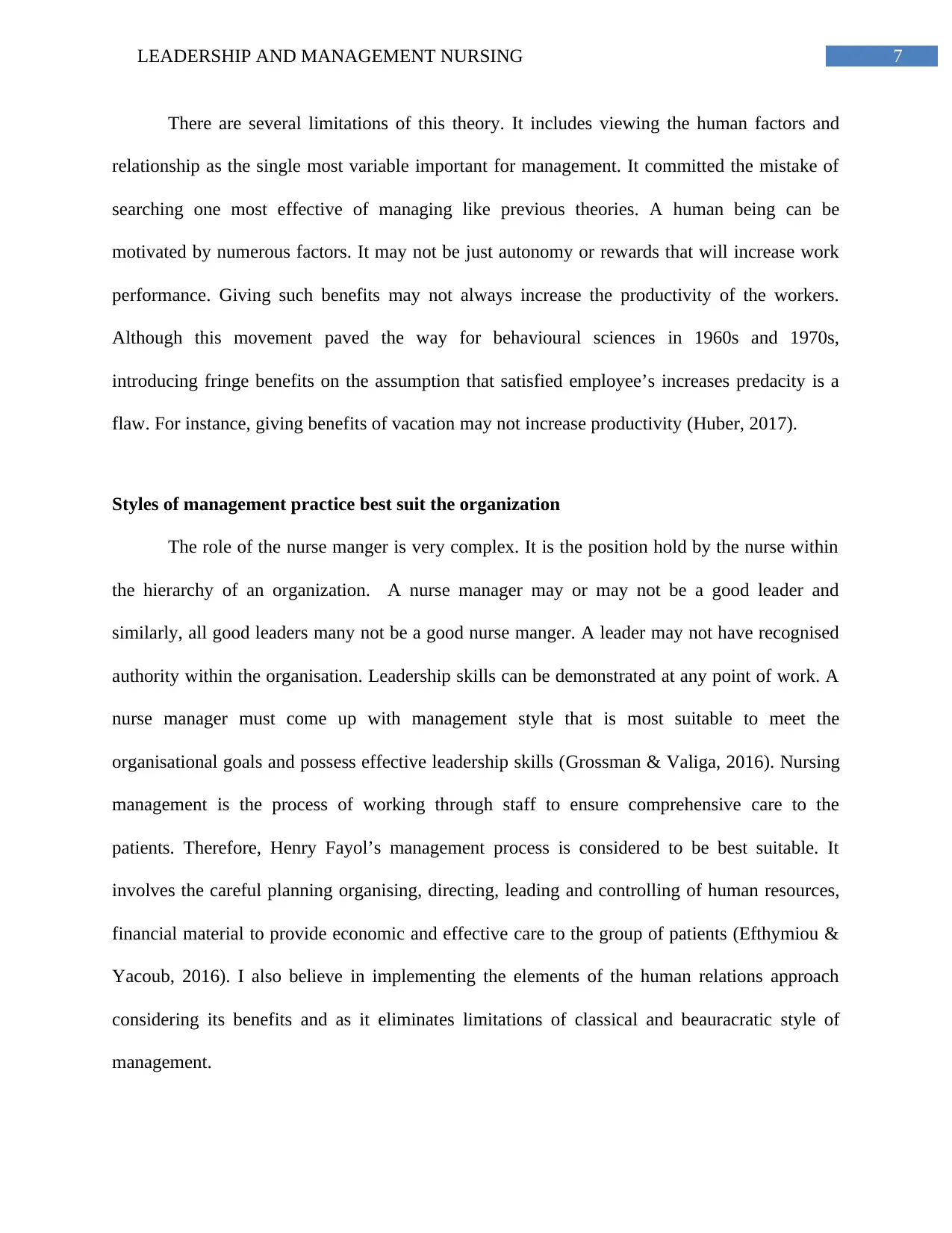
7LEADERSHIP AND MANAGEMENT NURSING
There are several limitations of this theory. It includes viewing the human factors and
relationship as the single most variable important for management. It committed the mistake of
searching one most effective of managing like previous theories. A human being can be
motivated by numerous factors. It may not be just autonomy or rewards that will increase work
performance. Giving such benefits may not always increase the productivity of the workers.
Although this movement paved the way for behavioural sciences in 1960s and 1970s,
introducing fringe benefits on the assumption that satisfied employee’s increases predacity is a
flaw. For instance, giving benefits of vacation may not increase productivity (Huber, 2017).
Styles of management practice best suit the organization
The role of the nurse manger is very complex. It is the position hold by the nurse within
the hierarchy of an organization. A nurse manager may or may not be a good leader and
similarly, all good leaders many not be a good nurse manger. A leader may not have recognised
authority within the organisation. Leadership skills can be demonstrated at any point of work. A
nurse manager must come up with management style that is most suitable to meet the
organisational goals and possess effective leadership skills (Grossman & Valiga, 2016). Nursing
management is the process of working through staff to ensure comprehensive care to the
patients. Therefore, Henry Fayol’s management process is considered to be best suitable. It
involves the careful planning organising, directing, leading and controlling of human resources,
financial material to provide economic and effective care to the group of patients (Efthymiou &
Yacoub, 2016). I also believe in implementing the elements of the human relations approach
considering its benefits and as it eliminates limitations of classical and beauracratic style of
management.
There are several limitations of this theory. It includes viewing the human factors and
relationship as the single most variable important for management. It committed the mistake of
searching one most effective of managing like previous theories. A human being can be
motivated by numerous factors. It may not be just autonomy or rewards that will increase work
performance. Giving such benefits may not always increase the productivity of the workers.
Although this movement paved the way for behavioural sciences in 1960s and 1970s,
introducing fringe benefits on the assumption that satisfied employee’s increases predacity is a
flaw. For instance, giving benefits of vacation may not increase productivity (Huber, 2017).
Styles of management practice best suit the organization
The role of the nurse manger is very complex. It is the position hold by the nurse within
the hierarchy of an organization. A nurse manager may or may not be a good leader and
similarly, all good leaders many not be a good nurse manger. A leader may not have recognised
authority within the organisation. Leadership skills can be demonstrated at any point of work. A
nurse manager must come up with management style that is most suitable to meet the
organisational goals and possess effective leadership skills (Grossman & Valiga, 2016). Nursing
management is the process of working through staff to ensure comprehensive care to the
patients. Therefore, Henry Fayol’s management process is considered to be best suitable. It
involves the careful planning organising, directing, leading and controlling of human resources,
financial material to provide economic and effective care to the group of patients (Efthymiou &
Yacoub, 2016). I also believe in implementing the elements of the human relations approach
considering its benefits and as it eliminates limitations of classical and beauracratic style of
management.

8LEADERSHIP AND MANAGEMENT NURSING
Among the leadership style the best suitable to meet the organisational goal is the
situational leadership style. It is the change of leadership style depending on the situation, as no
particular leadership style can be used for the entire situation. This model involves four
leadership styles. Telling leadership is used when repetitive results are required. Selling
leadership is used to gain cooperation especially when introducing change. For instance,
introduction of patient centered care model. Participation leadership is used to allow staff to
make choices. Delegating leadership is used to let nurses do their job. The situational leadership
model has been widely used in residential aged care sector and has been found to be successful
(Lynch, 2015). Apart from this transformational leadership is the best suitable for nursing
profession. This theory allows nurses to transform the healthcare. The components of this style
of leadership are intellectual stimulation, individualised consideration, idealised influence, and
inspirational motivation (Kossek et al., 2018).
Management process
Process of management that would be undertaken to ensure that the organizational
objectives are met; especially in today's challenging environment is discussed in this section.
Base on my personal experience and research conducted the nurse managers and the leaders must
play a significant role in solving various issues in nursing such as shortage of staff, training and
development needs, patient abuse, workload, financial cost and others.
The essentials of good planning for nurse managers and leaders are developing
alternative approaches to meet the organisational goals. Nurse Manager can come up with
different approaches to address the above mentioned nursing issues to make the health care
Among the leadership style the best suitable to meet the organisational goal is the
situational leadership style. It is the change of leadership style depending on the situation, as no
particular leadership style can be used for the entire situation. This model involves four
leadership styles. Telling leadership is used when repetitive results are required. Selling
leadership is used to gain cooperation especially when introducing change. For instance,
introduction of patient centered care model. Participation leadership is used to allow staff to
make choices. Delegating leadership is used to let nurses do their job. The situational leadership
model has been widely used in residential aged care sector and has been found to be successful
(Lynch, 2015). Apart from this transformational leadership is the best suitable for nursing
profession. This theory allows nurses to transform the healthcare. The components of this style
of leadership are intellectual stimulation, individualised consideration, idealised influence, and
inspirational motivation (Kossek et al., 2018).
Management process
Process of management that would be undertaken to ensure that the organizational
objectives are met; especially in today's challenging environment is discussed in this section.
Base on my personal experience and research conducted the nurse managers and the leaders must
play a significant role in solving various issues in nursing such as shortage of staff, training and
development needs, patient abuse, workload, financial cost and others.
The essentials of good planning for nurse managers and leaders are developing
alternative approaches to meet the organisational goals. Nurse Manager can come up with
different approaches to address the above mentioned nursing issues to make the health care
⊘ This is a preview!⊘
Do you want full access?
Subscribe today to unlock all pages.

Trusted by 1+ million students worldwide
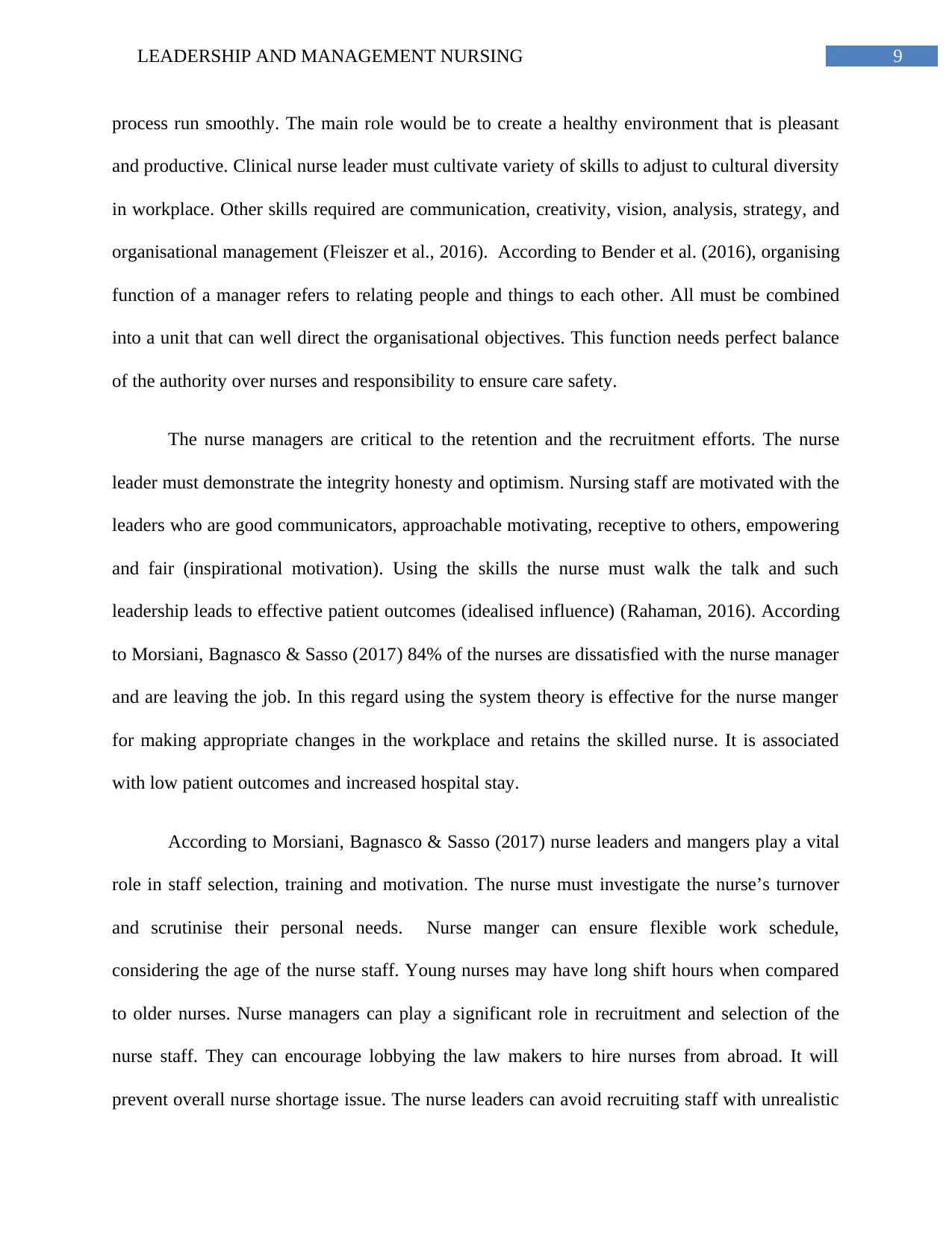
9LEADERSHIP AND MANAGEMENT NURSING
process run smoothly. The main role would be to create a healthy environment that is pleasant
and productive. Clinical nurse leader must cultivate variety of skills to adjust to cultural diversity
in workplace. Other skills required are communication, creativity, vision, analysis, strategy, and
organisational management (Fleiszer et al., 2016). According to Bender et al. (2016), organising
function of a manager refers to relating people and things to each other. All must be combined
into a unit that can well direct the organisational objectives. This function needs perfect balance
of the authority over nurses and responsibility to ensure care safety.
The nurse managers are critical to the retention and the recruitment efforts. The nurse
leader must demonstrate the integrity honesty and optimism. Nursing staff are motivated with the
leaders who are good communicators, approachable motivating, receptive to others, empowering
and fair (inspirational motivation). Using the skills the nurse must walk the talk and such
leadership leads to effective patient outcomes (idealised influence) (Rahaman, 2016). According
to Morsiani, Bagnasco & Sasso (2017) 84% of the nurses are dissatisfied with the nurse manager
and are leaving the job. In this regard using the system theory is effective for the nurse manger
for making appropriate changes in the workplace and retains the skilled nurse. It is associated
with low patient outcomes and increased hospital stay.
According to Morsiani, Bagnasco & Sasso (2017) nurse leaders and mangers play a vital
role in staff selection, training and motivation. The nurse must investigate the nurse’s turnover
and scrutinise their personal needs. Nurse manger can ensure flexible work schedule,
considering the age of the nurse staff. Young nurses may have long shift hours when compared
to older nurses. Nurse managers can play a significant role in recruitment and selection of the
nurse staff. They can encourage lobbying the law makers to hire nurses from abroad. It will
prevent overall nurse shortage issue. The nurse leaders can avoid recruiting staff with unrealistic
process run smoothly. The main role would be to create a healthy environment that is pleasant
and productive. Clinical nurse leader must cultivate variety of skills to adjust to cultural diversity
in workplace. Other skills required are communication, creativity, vision, analysis, strategy, and
organisational management (Fleiszer et al., 2016). According to Bender et al. (2016), organising
function of a manager refers to relating people and things to each other. All must be combined
into a unit that can well direct the organisational objectives. This function needs perfect balance
of the authority over nurses and responsibility to ensure care safety.
The nurse managers are critical to the retention and the recruitment efforts. The nurse
leader must demonstrate the integrity honesty and optimism. Nursing staff are motivated with the
leaders who are good communicators, approachable motivating, receptive to others, empowering
and fair (inspirational motivation). Using the skills the nurse must walk the talk and such
leadership leads to effective patient outcomes (idealised influence) (Rahaman, 2016). According
to Morsiani, Bagnasco & Sasso (2017) 84% of the nurses are dissatisfied with the nurse manager
and are leaving the job. In this regard using the system theory is effective for the nurse manger
for making appropriate changes in the workplace and retains the skilled nurse. It is associated
with low patient outcomes and increased hospital stay.
According to Morsiani, Bagnasco & Sasso (2017) nurse leaders and mangers play a vital
role in staff selection, training and motivation. The nurse must investigate the nurse’s turnover
and scrutinise their personal needs. Nurse manger can ensure flexible work schedule,
considering the age of the nurse staff. Young nurses may have long shift hours when compared
to older nurses. Nurse managers can play a significant role in recruitment and selection of the
nurse staff. They can encourage lobbying the law makers to hire nurses from abroad. It will
prevent overall nurse shortage issue. The nurse leaders can avoid recruiting staff with unrealistic
Paraphrase This Document
Need a fresh take? Get an instant paraphrase of this document with our AI Paraphraser
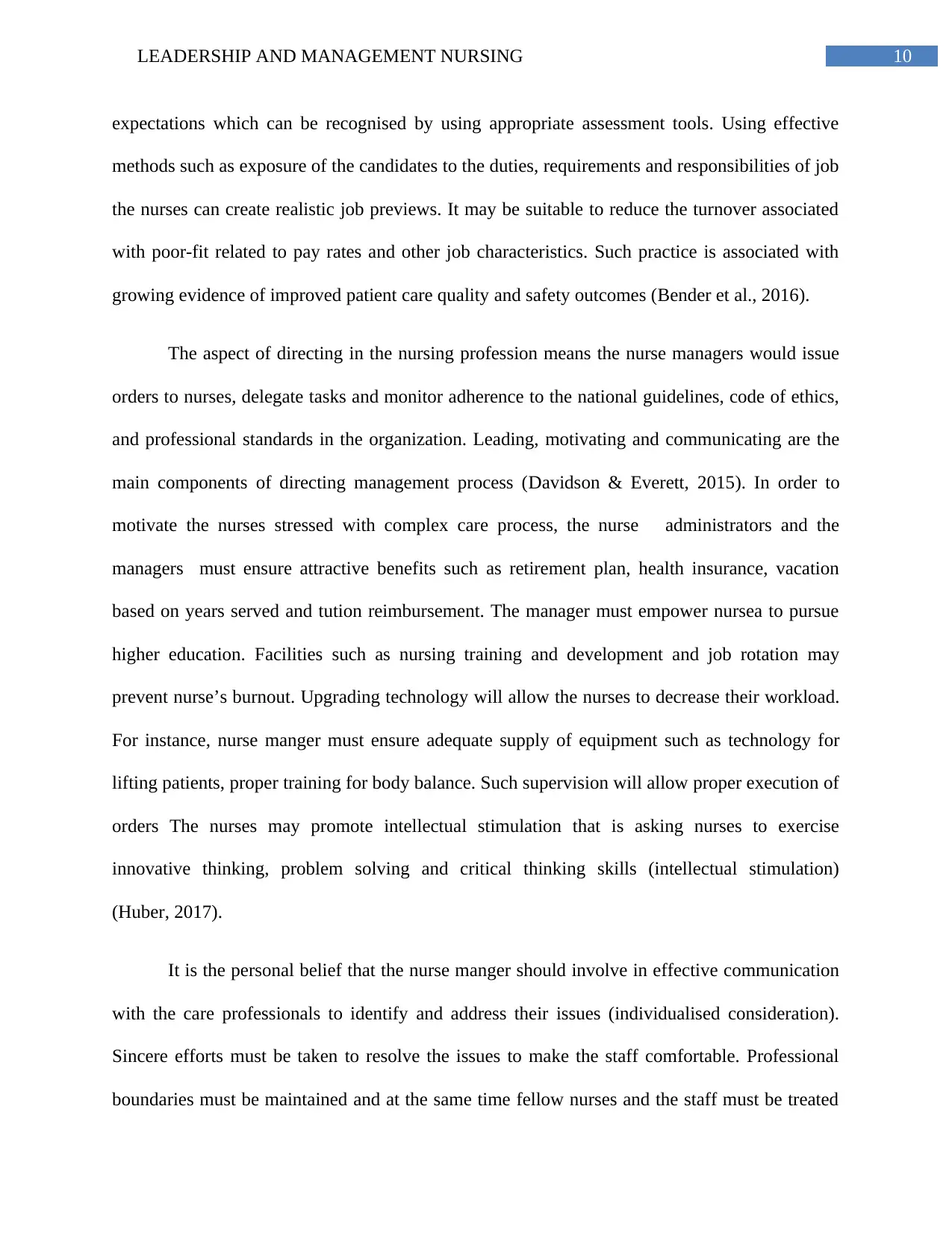
10LEADERSHIP AND MANAGEMENT NURSING
expectations which can be recognised by using appropriate assessment tools. Using effective
methods such as exposure of the candidates to the duties, requirements and responsibilities of job
the nurses can create realistic job previews. It may be suitable to reduce the turnover associated
with poor-fit related to pay rates and other job characteristics. Such practice is associated with
growing evidence of improved patient care quality and safety outcomes (Bender et al., 2016).
The aspect of directing in the nursing profession means the nurse managers would issue
orders to nurses, delegate tasks and monitor adherence to the national guidelines, code of ethics,
and professional standards in the organization. Leading, motivating and communicating are the
main components of directing management process (Davidson & Everett, 2015). In order to
motivate the nurses stressed with complex care process, the nurse administrators and the
managers must ensure attractive benefits such as retirement plan, health insurance, vacation
based on years served and tution reimbursement. The manager must empower nursea to pursue
higher education. Facilities such as nursing training and development and job rotation may
prevent nurse’s burnout. Upgrading technology will allow the nurses to decrease their workload.
For instance, nurse manger must ensure adequate supply of equipment such as technology for
lifting patients, proper training for body balance. Such supervision will allow proper execution of
orders The nurses may promote intellectual stimulation that is asking nurses to exercise
innovative thinking, problem solving and critical thinking skills (intellectual stimulation)
(Huber, 2017).
It is the personal belief that the nurse manger should involve in effective communication
with the care professionals to identify and address their issues (individualised consideration).
Sincere efforts must be taken to resolve the issues to make the staff comfortable. Professional
boundaries must be maintained and at the same time fellow nurses and the staff must be treated
expectations which can be recognised by using appropriate assessment tools. Using effective
methods such as exposure of the candidates to the duties, requirements and responsibilities of job
the nurses can create realistic job previews. It may be suitable to reduce the turnover associated
with poor-fit related to pay rates and other job characteristics. Such practice is associated with
growing evidence of improved patient care quality and safety outcomes (Bender et al., 2016).
The aspect of directing in the nursing profession means the nurse managers would issue
orders to nurses, delegate tasks and monitor adherence to the national guidelines, code of ethics,
and professional standards in the organization. Leading, motivating and communicating are the
main components of directing management process (Davidson & Everett, 2015). In order to
motivate the nurses stressed with complex care process, the nurse administrators and the
managers must ensure attractive benefits such as retirement plan, health insurance, vacation
based on years served and tution reimbursement. The manager must empower nursea to pursue
higher education. Facilities such as nursing training and development and job rotation may
prevent nurse’s burnout. Upgrading technology will allow the nurses to decrease their workload.
For instance, nurse manger must ensure adequate supply of equipment such as technology for
lifting patients, proper training for body balance. Such supervision will allow proper execution of
orders The nurses may promote intellectual stimulation that is asking nurses to exercise
innovative thinking, problem solving and critical thinking skills (intellectual stimulation)
(Huber, 2017).
It is the personal belief that the nurse manger should involve in effective communication
with the care professionals to identify and address their issues (individualised consideration).
Sincere efforts must be taken to resolve the issues to make the staff comfortable. Professional
boundaries must be maintained and at the same time fellow nurses and the staff must be treated

11LEADERSHIP AND MANAGEMENT NURSING
with respect at work and in community. With the help of collaborative council, mutual respect
can be developed among all the health care professionals. The management literature in nursing
suggests involving nurses in decision making to make them the part of team. It will help address
the challenge of staffing in the active workforce. Effective communication will help to facilitate
coordination and control, which is again essential of good planning (Wagner et al., 2015).
Another crucial part of the management process is the leadership. Effective interaction
between the nurse staff and the nurse leaders will lead to successful leadership. Various styles of
leadership are available such as transformational, democratic participative leadership, and
autocratic leadership. I believe that situational leadership is the most effective leadership style.
The controlling aspect of the management by clinical nurse leader involves regulation of
activities in accordance with the set plans. It refers to established standards, measuring
performance and comparing actual result with standards and addressing deviations (Weiss &
Tappen, 2014). For instance nurse leaders can set standards or policy for hand hygiene. It will
help monitor the rise or fall in noscomial infections. It will help nurse to address the barriers to
compliance with hand hygiene policy. This controlling aspect of the management process is
applicable for clinical nurse leader in medical care as well as other clinical aspects.
Conclusion
In conclusion the nurse must involve in evidence based management style. There are
different leadership styles and theories. The nurse manger must pick up management style that
has less limitation and more advantages. Based on research conducted and personal experience
transformational and situational leadership are most effective. I consider the Henry Fayol’s
management process to be best suitable. The most effective nurse emerges from strong
with respect at work and in community. With the help of collaborative council, mutual respect
can be developed among all the health care professionals. The management literature in nursing
suggests involving nurses in decision making to make them the part of team. It will help address
the challenge of staffing in the active workforce. Effective communication will help to facilitate
coordination and control, which is again essential of good planning (Wagner et al., 2015).
Another crucial part of the management process is the leadership. Effective interaction
between the nurse staff and the nurse leaders will lead to successful leadership. Various styles of
leadership are available such as transformational, democratic participative leadership, and
autocratic leadership. I believe that situational leadership is the most effective leadership style.
The controlling aspect of the management by clinical nurse leader involves regulation of
activities in accordance with the set plans. It refers to established standards, measuring
performance and comparing actual result with standards and addressing deviations (Weiss &
Tappen, 2014). For instance nurse leaders can set standards or policy for hand hygiene. It will
help monitor the rise or fall in noscomial infections. It will help nurse to address the barriers to
compliance with hand hygiene policy. This controlling aspect of the management process is
applicable for clinical nurse leader in medical care as well as other clinical aspects.
Conclusion
In conclusion the nurse must involve in evidence based management style. There are
different leadership styles and theories. The nurse manger must pick up management style that
has less limitation and more advantages. Based on research conducted and personal experience
transformational and situational leadership are most effective. I consider the Henry Fayol’s
management process to be best suitable. The most effective nurse emerges from strong
⊘ This is a preview!⊘
Do you want full access?
Subscribe today to unlock all pages.

Trusted by 1+ million students worldwide
1 out of 17
Related Documents
Your All-in-One AI-Powered Toolkit for Academic Success.
+13062052269
info@desklib.com
Available 24*7 on WhatsApp / Email
![[object Object]](/_next/static/media/star-bottom.7253800d.svg)
Unlock your academic potential
Copyright © 2020–2025 A2Z Services. All Rights Reserved. Developed and managed by ZUCOL.





